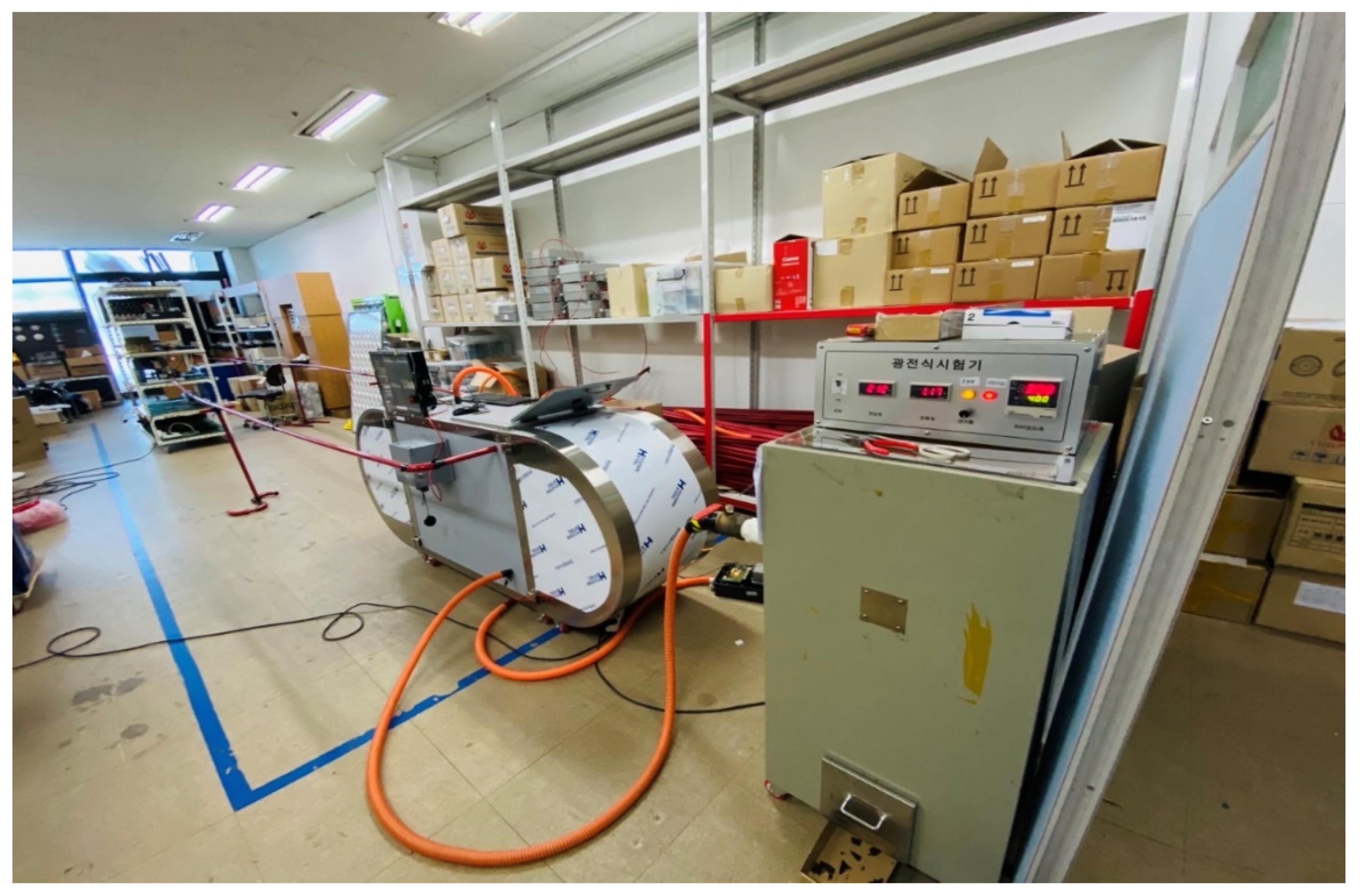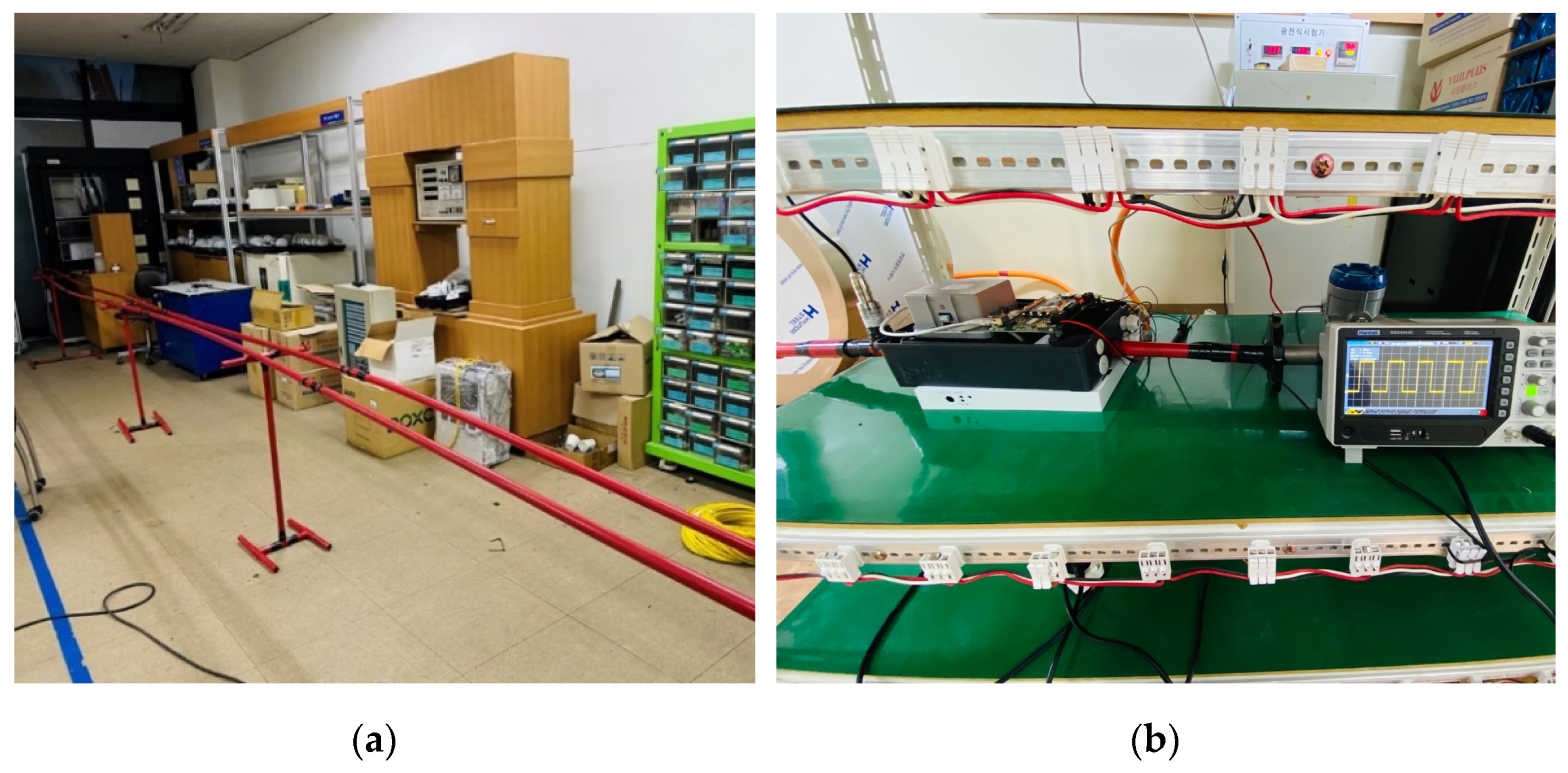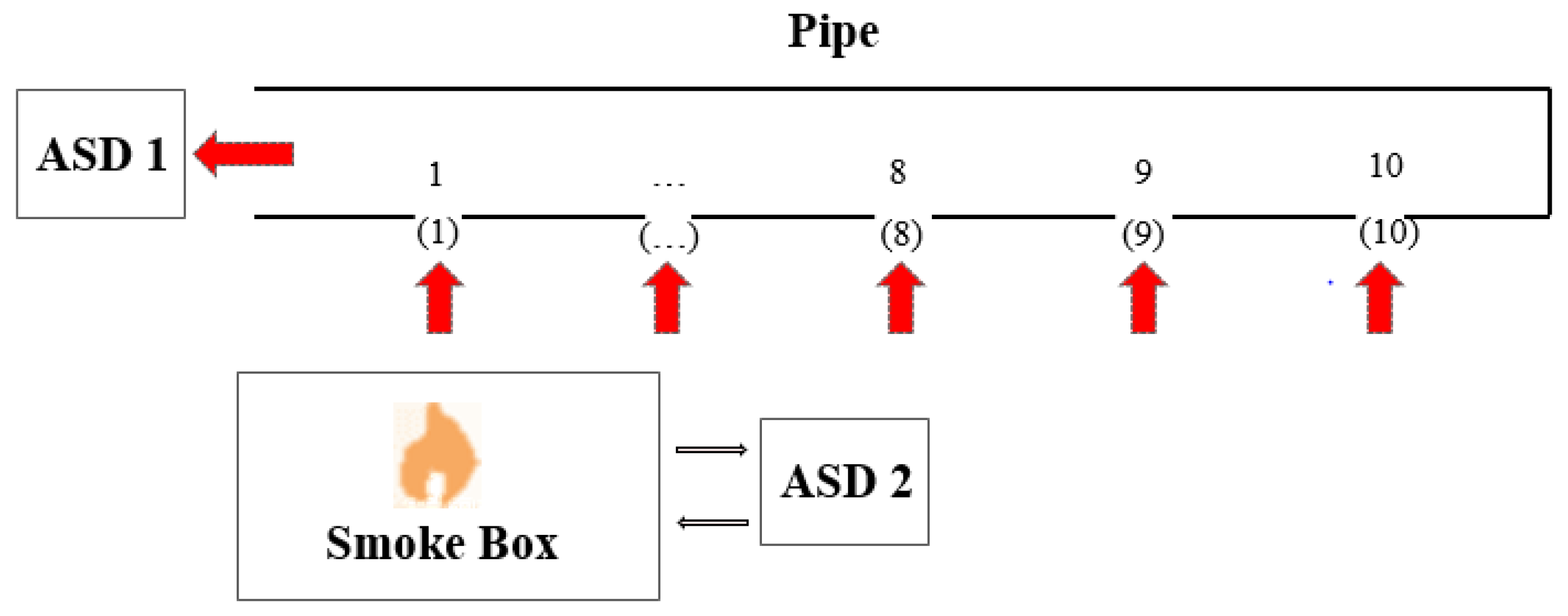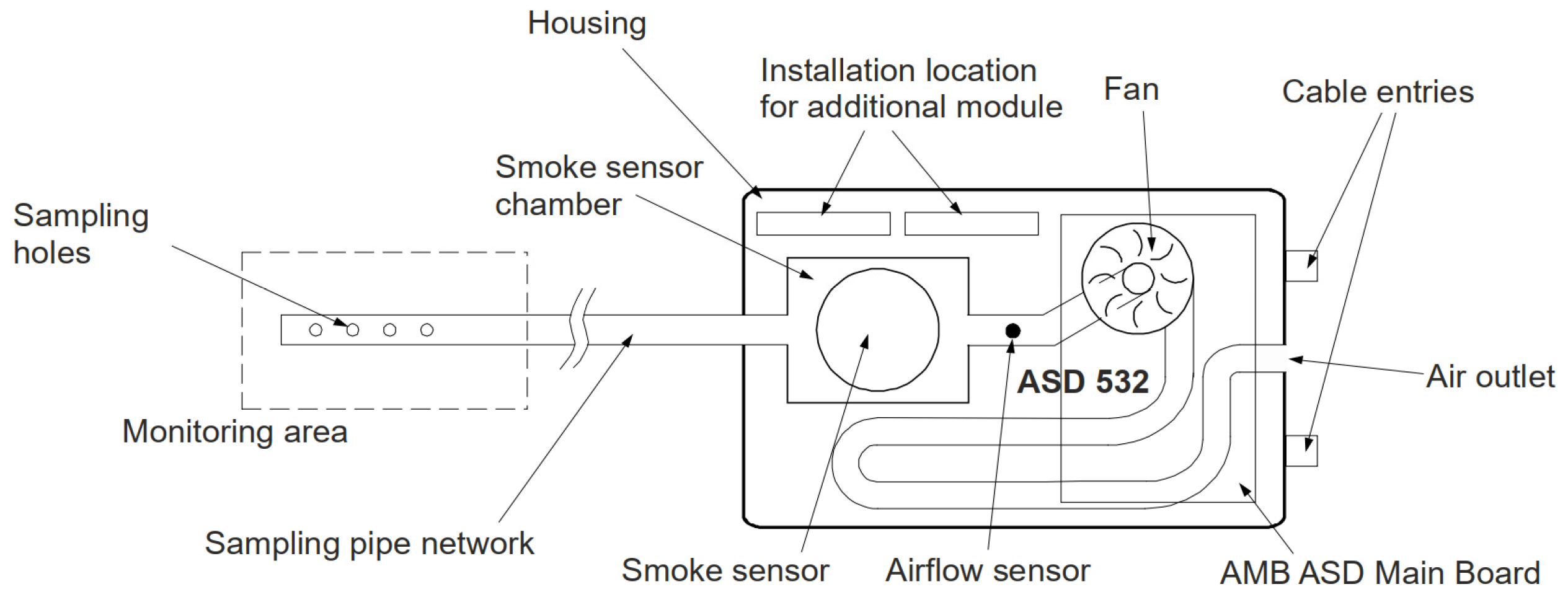Predicting the Fire Source Location by Using the Pipe Hole Network in Aspirating Smoke Detection System
Abstract
:1. Introduction
2. Theoretical Analysis
2.1. Pressure Drop in the Pipe Network
2.2. Obscuration
3. Numerical and Experimental Studies
3.1. Numerical Study
3.1.1. Mathematical Model
3.1.2. Numerical Setup
- 1.
- ASD system with one branch pipe with ten holes.
- 2.
- ASD system with one branch pipe with twenty holes.
3.2. Experimental Study
4. Results and Discussion
4.1. ASD System with One Branch Pipe with Ten Holes
4.2. ASD System with One Branch Pipe with Twenty Holes
5. Conclusions
Author Contributions
Funding
Institutional Review Board Statement
Informed Consent Statement
Data Availability Statement
Acknowledgments
Conflicts of Interest
Abbreviations
| ASD | Aspirating smoke detetion |
| f | Friction factor |
| D | Pipe diameter |
| ρ | Fluid density |
| e | Pipe roughness |
| hlm | Minor loss |
| Mass flow rate at sampling point i | |
| td,I | The prior (delay) at current time |
| V(1),s | Flowrate of smoke at location (1) |
| V1,s | Flowrate of smoke at location 1 |
| C(1) | Smoke concentration at location (1) |
| V(2),s | Flowrate of smoke at location (2) |
| V2,s | Flowrate of smoke at location 2 |
| C(2) | Smoke concentration at location (2) |
| C(n) | Smoke concentration at location (n) |
| OD | Optical density |
| Smoke concentration | |
| Particle diameter | |
| P(1) | Pressure at location (1) |
| Qin | Flowrate of fluid through the hole |
| S | Slope |
| Normalized length | |
| hl | Head loss |
| L | Pipe length |
| V | Velocity |
| Re | Reynolds number |
| K | Fitting loss factor |
| OBS | Obscuration |
| Soot density | |
| Km | Mass extinction coefficient |
| V(1),t | Total flow rate at location (1) |
| V1,t | Total flow rate at location 1 |
| C1 | Smoke concentration at location 1 |
| V(2),t | Total flow rate at location (2) |
| V2,t | Total flow rate at location 2 |
| C2 | Smoke concentration at location 2 |
| Cn | Smoke concentration at location n |
| Path lengh | |
| Number count | |
| P1 | Pressure at location 1 |
| Pressure drop at first hole | |
| Q | Flowrate of mainflow in the pipe |
| R | Obscuration ratio |
Appendix A
| Technical Data | Specification | ASD 532 |
|---|---|---|
| Supply voltage range | EN 54 | 14.0–30 VDC |
| FM/UL | 16.4–27 VDC | |
| Power consumption | Typical for 24 VDC | 115 mA |
| Sampling tubes | Quantity | 1 |
| Alarm sensitivity | Alarm | 0.02–10%/m |
| Monitoring area | Max. area | 1280 m2 |
| System limits without conformity to standards | Max. overall length of all sampling tubes | 120 m |
| Fan/sampling system | Suction pressure Service life (MTTF) Noise level (1 m distance) | >100 Pa >8000 h (at 40 °C) 25 dB(A) |
| Airflow monitoring | As per EN 54-20 | 1 air flow sensor |
| Flow meter | Output: DC 4–20 mA, Range: 0~30 Nm3/h, Accuracy: ±0.5% Model: KSMG-8000 | |
| Pressure sensor | Range: 0–25 mbar, Accuracy: 0.2% Model: CPH6300 | |
| Oscilloscope | Output Voltage: About 2 Vpp into ≥ 1 MΩ, Band: 250 Mhz, Frequency Resolution: 0.1% Model: DSO4254C | |
| Light meter | Digital Output: USB, Range: 0.01 to 299,900 lx; Accuracy: ±2% ±1 digit of displayed value Model: Illuminace Meter T-10A |



References
- Cheng, L.; Zhou, H.; Yang, H. The Simulation of the Sampling Pipes and Sampling Holes Network with an Aspirating Smoke Detector. In Proceedings of the JFPS International Symposium on Fluid Power, Tsukuba, Japan, 7–10 November 2005; The Japan Fluid Power System Society: Tokyo, Japan, 2005; Volume 2005, pp. 386–390. [Google Scholar]
- Carello, M.; Ivanov, A.; Mazza, L. Pressure drop in pipe lines for compressed air: Comparison between experimental and theoretical analysis. WIT Trans. Eng. Sci. 1970, 18, 10. [Google Scholar]
- Essienubong, I.A.; Ejiroghene, K.O. Pressure Losses Analysis in Air Duct Flow Using Computational Fluid Dynamics (CFD). Int. Acad. J. Sci. Eng. 2016, 3, 55–70. [Google Scholar]
- Gajbhiye, B.; Kulkarni, H.A.; Tiwari, S.S.; Mathpati, C.S. Teaching turbulent flow through pipe fittings using computational fluid dynamics approach. Eng. Rep. 2020, 2, e12093. [Google Scholar] [CrossRef] [Green Version]
- Perumal, K.; Rajamohan, G. CFD modeling for the estimation of pressure loss coefficients of pipe fittings: An undergraduate project. Comput. Appl. Eng. Educ. 2016, 24, 180–185. [Google Scholar] [CrossRef]
- Singh, R.K. A Study of Air Flow in a Network of Pipes Used in Aspirated Smoke Detectors. Ph.D. Thesis, Victoria University, Melbourne, Australia, 2009. [Google Scholar]
- Gai, Y.; Cai, M.; Shi, Y. Analytical and experimental study on complex compressed air pipe network. Chin. J. Mech. Eng. 2015, 28, 1023–1029. [Google Scholar] [CrossRef]
- Huang, Y.; Wang, E.; Bie, Y. Simulation investigation on the smoke spread process in the large-space building with various height. Case Stud. Therm. Eng. 2020, 18, 100594. [Google Scholar] [CrossRef]
- Huang, Y.; Chen, X.; Zhang, C. Numerical simulation of the variation of obscuration ratio at the fire early phase with various soot yield rate. Case Stud. Therm. Eng. 2020, 18, 100572. [Google Scholar] [CrossRef]
- Zhenna, Z.; Qin, Z.; Hongbing, C.; Suilin, W.; Hongwen, L. Performance study on fire alarm system in large space buildings. In Recent Advances in Computer Science and Information Engineering; Springer: Berlin/Heidelberg, Germany, 2012; pp. 69–73. [Google Scholar]
- Krope, J.; Dobersek, D.; Goricanec, D. Flow pressure analysis of pipe networks with linear theory method. In Proceedings of the 2006 WSEAS/IASME International Conference on Fluid Mechanics, Miami, FL, USA, 18–20 January 2006. [Google Scholar]
- Qian, Y.; Zhu, D.Z.; Edwini-Bonsu, S. Air flow modeling in a prototype sanitary sewer system. J. Environ. Eng. 2018, 144, 04018008. [Google Scholar] [CrossRef]
- Quraishi, M.S. Prediction of fan assisted flow in a duct/pipe network. In Proceedings of the 1996 CNA/CNS Conference, Fredericton, NB, Canada, 9–12 June 1996. [Google Scholar]
- Brkić, D.; Praks, P. An efficient iterative method for looped pipe network hydraulics free of flow-corrections. Fluids 2019, 4, 73. [Google Scholar] [CrossRef] [Green Version]
- Lang, S. Variable Air Speed Aspirating Smoke Detector. U.S. Patent 8,098,166, 17 January 2012. [Google Scholar]
- Nagy, T.; Jílek, A.; Pečínka, J. Air flow rate measurement with various differential pressure methods. In Proceedings of the 2017 International Conference on Military Technologies (ICMT), Brno, Czech Republic, 31 May–2 June 2017; IEEE: Piscataway, NJ, USA, 2017; pp. 535–541. [Google Scholar]
- Anantharaman, V.; Waterson, N.; Nakiboglu, G.; Persin, M.; van Oudheusden, B. Experimental investigation of turbulent flow through single-hole orifice placed in a pipe by means of time-resolved Particle Image Velocimetry and unsteady pressure measurements. In Proceedings of the 11th International Conference on Flow-Induced Vibrations, Den Haag, The Netherlands, 4–6 July 2016. [Google Scholar]
- Grant, G.; Drysdale, D. Numerical modelling of early flame spread in warehouse fires. Fire Saf. J. 1995, 24, 247–278. [Google Scholar] [CrossRef]
- Lönnermark, A.; Ingason, H. Fire Spread in Large Industrial Premises and Warehouse; SP Swedish National Testing and Research Institute: Borås, Sweden, 2005. [Google Scholar]
- Muckett, M.; Furness, A. Introduction to Fire Safety Management; Routledge: London, UK, 2007. [Google Scholar]
- Liu, S.; Luo, X.; Yao, W.; Chen, C.; Kun, Y.; Yi, M.; Hu, H.; Zhang, Y. Aspirating fire detection system with high sensitivity and multi-parameter. In Proceedings of the 2014 International Conference on Information Science, Electronics and Electrical Engineering, Sapporo, Japan, 26–28 April 2014; IEEE: Piscataway, NJ, USA, 2014. [Google Scholar]
- Shaltout, R.E.; Ismail, M.A. Simulation of Fire Dynamics and Firefighting System for a Full-Scale Passenger Rolling Stock. In Sustainable Rail Transport; Springer: Cham, Switzerland, 2020; pp. 209–228. [Google Scholar]
- Johnson, P.; Beyler, C.; Croce, P.; Dubay, C.; McNamee, M. Very Early Smoke Detection Apparatus (VESDA), David Packham, John Petersen, Martin Cole: 2017 DiNenno Prize. Fire Sci. Rev. 2017, 6, 1–12. [Google Scholar] [CrossRef] [Green Version]
- Zhang, Z.N.; Chen, H.B. Simulation Study on the Aspirating Smoke Detection System in Large Space Buildings. In Advanced Materials Research; Trans Tech Publications: Baech, Switzerland, 2011; Volume 255, pp. 1404–1408. [Google Scholar]
- Brown, G.O. The history of the Darcy-Weisbach equation for pipe flow resistance. In Proceedings of the Environmental and Water Resources History Sessions at ASCE Civil Engineering Conference and Exposition, Washington, DC, USA, 3–7 November 2002; ASCE: Reston, VA, USA, 2003; pp. 34–43. [Google Scholar]
- Cole, M. Disturbance of Flow Regimes by Jet Induction. Ph.D. Thesis, Victoria University of Technology, Melbourne, Australia, 1999. [Google Scholar]
- Munson, B.R.; Young, D.F.; Okiishi, T.H. Fundamentals of Fluid Mechanics; John Wiley & Sons: Hoboken, NJ, USA, 1998; pp. 199–200. [Google Scholar]
- McDermott, R.; McGrattan, K.; Hostikka, S. Fire dynamics simulator (version 5) technical reference guide. NIST Spec. Publ. 2008, 1018, 5. [Google Scholar]
- Fabian, T.Z.; Gandhi, P.D. Smoke Characterization Project; Fire Protection Research Foundation/Underwriters Laboratories, Incorporated: Quincy, MA, USA, 2007. [Google Scholar]
- Miller, J.H.T., IV. Analyzing Photo-Electric Smoke Detector Response Based on Aspirated Smoke Detector Obscuration; University of Maryland: College Park, MD, USA, 2010. [Google Scholar]
- Securition: SecuriSmoke ASD Aspirating Smoke Detectors the Complete Model Range for Any Application. Available online: https://www.securiton.com/products-services/smoke-detection-systems/securismoke-asd (accessed on 26 January 2022).









| Hole | Distance from Hole to ASD 1 (m) | Hole Diameter (mm) | Hole Distance (m) |
|---|---|---|---|
| 1 | 2 | 5 | 2 |
| 2 | 4 | 5 | 2 |
| 3 | 6 | 5 | 2 |
| 4 | 8 | 5 | 2 |
| 5 | 10 | 5 | 2 |
| 6 | 12 | 5 | 2 |
| 7 | 14 | 5 | 2 |
| 8 | 16 | 5 | 2 |
| 9 | 18 | 5 | 2 |
| 10 | 20 | 5 | 2 |
| Hole | Distance from Hole to ASD 1 (m) | Hole Diameter (mm) | Hole Distance (m) |
|---|---|---|---|
| 1 | 1 | 5 | 1 |
| 2 | 2 | 5 | 1 |
| 3 | 3 | 5 | 1 |
| 4 | 4 | 5 | 1 |
| … | … | … | … |
| 16 | 16 | 5 | 1 |
| 17 | 17 | 5 | 1 |
| 18 | 18 | 5 | 1 |
| 19 | 19 | 5 | 1 |
| 20 | 20 | 5 | 1 |
| Hole 1 | Hole 2 | Hole 3 | Hole 4 | Hole 5 | Hole 6 | Hole 7 | Hole 8 | Hole 9 | Hole 10 | |
|---|---|---|---|---|---|---|---|---|---|---|
| Obscuration (%/m) | 0.95 | 0.85 | 0.74 | 0.67 | 0.6 | 0.55 | 0.45 | 0.42 | 0.4 | 0.37 |
| Hole 1 | Hole 2 | Hole 3 | Hole 4 | Hole 5 | Hole 6 | Hole 7 | Hole 8 | Hole 9 | Hole 10 | |
|---|---|---|---|---|---|---|---|---|---|---|
| Obscuration (%/m) | 1.74 | 1.54 | 1.38 | 1.24 | 1.1 | 0.98 | 0.91 | 0.85 | 0.8 | 0.76 |
| Hole 1 | Hole 2 | Hole 3 | Hole 4 | Hole 5 | Hole 6 | Hole 7 | Hole 8 | Hole 9 | Hole 10 | |
|---|---|---|---|---|---|---|---|---|---|---|
| Obscuration (%/m) | 2.52 | 2.23 | 2.02 | 1.79 | 1.59 | 1.48 | 1.36 | 1.2 | 1.17 | 1.07 |
| Hole | Slope | ASD Obscuration (%/m) | Chamber Obscuration (%/m) | Obscuration Ratio (%/m) |
|---|---|---|---|---|
| 1 | 0.10556 | 0.9533 | 5 | 0.1907 |
| 2 | 0.09407 | 0.84667 | 5 | 0.1693 |
| 3 | 0.08222 | 0.7400 | 5 | 0.148 |
| 4 | 0.07444 | 0.66667 | 5 | 0.1334 |
| 5 | 0.06 | 0.60333 | 5 | 0.1207 |
| 6 | 0.0490 | 0.55 | 5 | 0.11 |
| 7 | 0.03359 | 0.44667 | 5 | 0.089 |
| 8 | 0.025625 | 0.42333 | 5 | 0.084 |
| 9 | 0.019048 | 0.4033 | 5 | 0.081 |
| 10 | 0.00982 | 0.3733 | 5 | 0.0747 |
| Hole | Slope | ASD Obscuration (%/m) | Chamber Obscuration (%/m) | Obscuration Ratio (%/m) |
|---|---|---|---|---|
| 1 | 0.1952 | 1.74 | 10 | 0.174 |
| 2 | 0.1707 | 1.54 | 10 | 0.154 |
| 3 | 0.1387 | 1.38 | 10 | 0.138 |
| 4 | 0.1124 | 1.24 | 10 | 0.124 |
| 5 | 0.0994 | 1.1 | 10 | 0.11 |
| 6 | 0.0754 | 0.983 | 10 | 0.098 |
| 7 | 0.0645 | 0.91 | 10 | 0.091 |
| 8 | 0.0444 | 0.853 | 10 | 0.085 |
| 9 | 0.0315 | 0.8 | 10 | 0.08 |
| 10 | 0.0241 | 0.76 | 10 | 0.076 |
| Hole | Slope | ASD Obscuration (%/m) | Chamber Obscuration (%/m) | Obscuration Ratio (%/m) |
|---|---|---|---|---|
| 1 | 0.2796 | 2.523 | 15 | 0.168 |
| 2 | 0.224 | 2.23 | 15 | 0.149 |
| 3 | 0.1821 | 2.02 | 15 | 0.135 |
| 4 | 0.1519 | 1.787 | 15 | 0.119 |
| 5 | 0.1233 | 1.593 | 15 | 0.1061 |
| 6 | 0.0976 | 1.483 | 15 | 0.098 |
| 7 | 0.0845 | 1.363 | 15 | 0.0908 |
| 8 | 0.0571 | 1.203 | 15 | 0.0802 |
| 9 | 0.0426 | 1.17 | 15 | 0.078 |
| 10 | 0.0321 | 1.073 | 15 | 0.0715 |
Publisher’s Note: MDPI stays neutral with regard to jurisdictional claims in published maps and institutional affiliations. |
© 2022 by the authors. Licensee MDPI, Basel, Switzerland. This article is an open access article distributed under the terms and conditions of the Creative Commons Attribution (CC BY) license (https://creativecommons.org/licenses/by/4.0/).
Share and Cite
Lee, Y.M.; Thien Khieu, H.; Kim, D.W.; Kim, J.T.; Ryou, H.S. Predicting the Fire Source Location by Using the Pipe Hole Network in Aspirating Smoke Detection System. Appl. Sci. 2022, 12, 2801. https://doi.org/10.3390/app12062801
Lee YM, Thien Khieu H, Kim DW, Kim JT, Ryou HS. Predicting the Fire Source Location by Using the Pipe Hole Network in Aspirating Smoke Detection System. Applied Sciences. 2022; 12(6):2801. https://doi.org/10.3390/app12062801
Chicago/Turabian StyleLee, Young Man, Ha Thien Khieu, Dong Woo Kim, Ji Tae Kim, and Hong Sun Ryou. 2022. "Predicting the Fire Source Location by Using the Pipe Hole Network in Aspirating Smoke Detection System" Applied Sciences 12, no. 6: 2801. https://doi.org/10.3390/app12062801
APA StyleLee, Y. M., Thien Khieu, H., Kim, D. W., Kim, J. T., & Ryou, H. S. (2022). Predicting the Fire Source Location by Using the Pipe Hole Network in Aspirating Smoke Detection System. Applied Sciences, 12(6), 2801. https://doi.org/10.3390/app12062801







